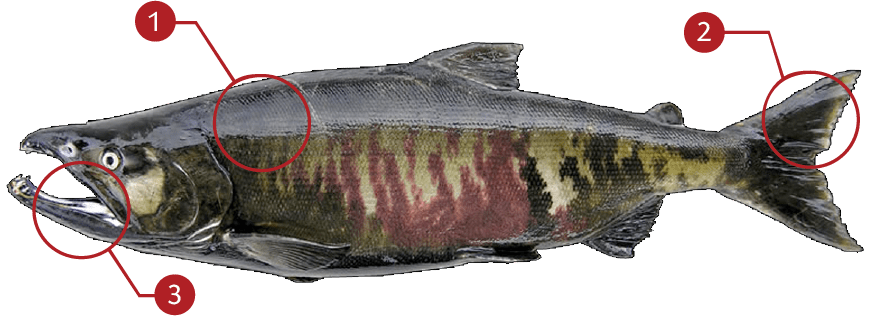CHUM SALMON
How to identify a Chum Salmon
At sea, chum salmon are silvery and have no distinct black spots, though they may have fine black speckling on the upper sides and back. Spawning males turn olive green with blood red vertical markings reaching up the sides, making this one of the most easily recognized Pacific salmon species. The color of spawning females is less vivid, but essentially the same. Breeding males of the species have large, exposed teeth, which may be the origin of the name “dog salmon,” though it is also said that this name evolved because this species was often fed to sled dogs.These fish average around 5-10 pounds but fish of up to 25 pounds are fairly common.
Where to catch Chum Salmon
The chum salmon is endemic to the Pacific and Arctic oceans, Bering Sea, the Sea of Japan and the Okhotsk Sea. In North America it occurs from the San Lorenzo River, California, to northwest Alaska, and east to the Peel, MacKenzie and possibly Anderson Rivers in Canada. During spawning it is known to ascend some rivers for considerable distances with some fish traveling over 1,200 miles. In the MacKenzie River, N.W.T., Canada, chum salmon travel all the way to the mouth of the Hay River and to the rapids below Fort Smith on the Slave River, entering both Great Bear and Great Slave Lakes and traveling through the Northwest Territories to the edge of Alberta, Canada. Like all Pacific salmons, with the exception of landlocked specimens, the chum salmon is anadromous and will spend most of its life in the ocean until spawning time when it enters freshwater rivers.
IDENTIFICATION

| |
Males are dark blue above with reddish-purple vertical markings |
| |
No distinct black spots on back or caudal fins |
| |
Lower gum line is black |
TARGET AREAS
|
|
Acknowledgements: We thank TAKEMEFISHING.org (www.takemefishing.org), Wisconsin Department of Natural Resources, Indiana Department of Natural Resources for their contributions to these FISH FACTS.

